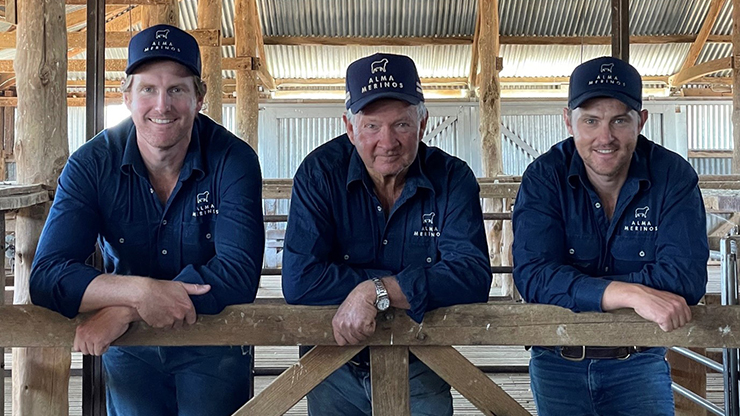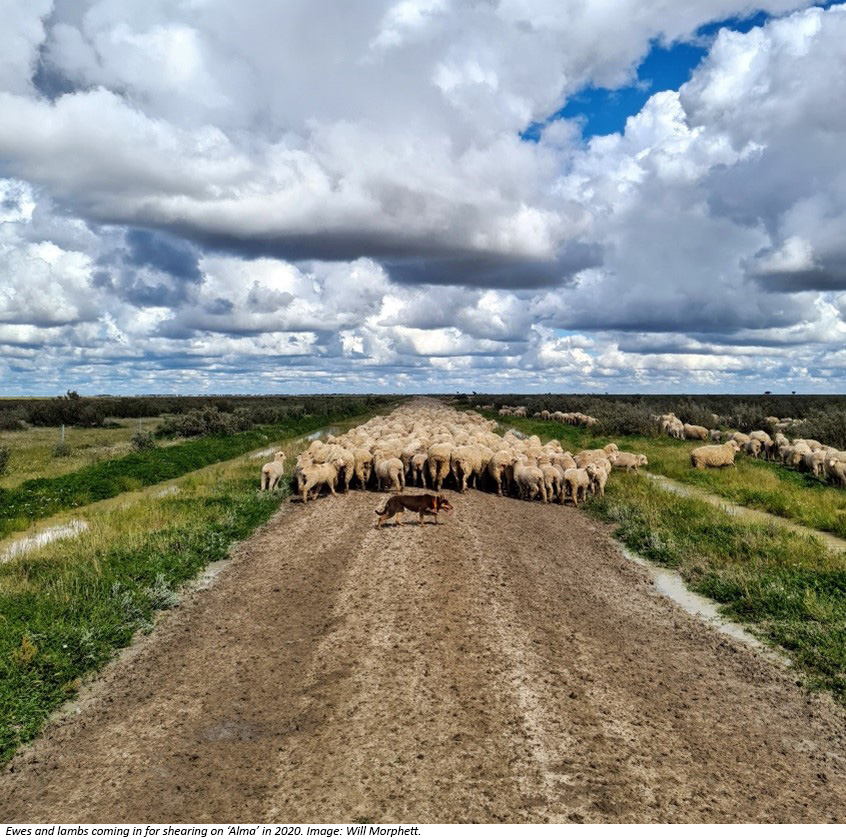
Grazing for long-term gain
Peter, Graham and William Morphett. Image: Zelda Chambers.
Managing stocking rates and running low-maintenance livestock are just two of the strategies NSW producer Will Morphett and his family employ to protect and capitalise on their natural assets despite variable seasons.
The Morphetts, who have owned ‘Alma’ at Booligal for more than 60 years, take a strategic, long-term management approach to their grazing enterprise to minimise the impact of the region’s highly variable rainfall on their pastures and productivity.
“Our biggest issue is trying to maximise our profitability while balancing variability in seasonal rainfall,” Will said.
“Our rainfall is not necessarily winter dominant – it varies seasonally as to whether you get more in winter or if it’s spread out throughout the year.”
Stocking rates
To counter these seasonal challenges, the Morphetts pay close attention to stocking rates to ensure Alma’s native pastures are grazed in a way that is not only profitable for their business, but is also sustainable.
“Our main tool for managing that variability out here is stocking rate,” Will said.
“We take a reasonably conservative approach to our stocking rate in order to protect pastures for the long term.”
The Morphetts’ grazing strategy includes shifting stock off areas with poorer pastures to allow pastures to regenerate sufficiently and remain productive for seasons to come.
“We’ll identify paddocks which we might want to improve or which we might have a certain goal for – such as more ground cover, more diversity or more of a certain type of species – and then we’ll try to manage to achieve that goal,” Will said.
“This can mean destocking areas over key growth periods and allowing pastures to regenerate and become established.
“As a general rule, we aim to keep ground cover above 50% and place a particular focus on keeping perennial bushes, particularly saltbush, as well as perennial grasses in our system.”
Hardy stock
Low-maintenance Merino sheep is another key element of the family’s property management strategy for long term productivity and natural asset health.
“Low-maintenance livestock are animals that can utilise the pasture – animals with a large body and long legs, so they can walk out from a watering point to get food as opposed to being restricted around a watering point and running that country hard.”
Watering points are placed strategically to keep pressure on pastures to a minimum, while trying to maintain lambing rates above 100%.
“We make sure we’ve got plenty of watering points spread out around the country – that helps us out with lambing percentages and feed utilisation across the property,” Will said.
“We try to avoid having one section of a paddock that gets really run down by stock because that area won’t regenerate as effectively in the future.”
Biosecurity
Careful management of pests and weeds on the property also ensures native pastures can thrive. In particular, the Morphetts focus on feral animals such as pigs and foxes, and invasive weed species such as African boxthorn, Noogoora burr and Bathurst burr.
“We use spot spraying to manage these weeds, targeting key areas such as channel systems, ground tanks and creek systems because that’s where they often like to grow,” Will said.
“A lot of those weeds are invasive, so if we can exclude them, it helps keep our native pastures as healthy and productive as possible.”
Understanding the environment
Will prioritises ongoing education and research to further improve his management.
One of the latest workshops he’s attended is the Improving Tactical Decision Making pilot program, hosted as part of the MLA-funded Profitable Grazing Systems (PGS) program conducted in partnership with Local Land Services.
“It has been great to get local landholders together through the program and compare the different strategies we use to manage the landscape,” Will said.
“We’ve been learning more about how the natural system operates out here and how we may be able to manage it.
“The last two years of above-average rainfall in this region has really highlighted the ability of this environment to regenerate when managed well.”
Long-term benefit
Will said the family’s careful management of their natural assets on-farm was key to the ongoing productivity of their business.
“It works hand in hand – good management of our pastures has flowed on to good results in our stock, with our lambing rates in excess of 100% and the flock producing a 21 micron wool clip.
“If you’ve got a healthy environment with lots of species diversity and great ground cover, your country will be able to respond effectively to a rainfall event and grow more feed.
“That means you’ll have more feed available to your stock, who can use that to produce more lambs and more wool.”
Healthy pastures will also ensure the sustainability of livestock enterprises for generations to come, despite the variable seasons.
“If you run the country hard and deplete the seed base of a species, it’s going to take a long, long time for those seeds to spread and for the species to become established in the paddock,” Will said.
“I think now there’s a lot greater understanding of that and a lot more respect for those native environments and pastures – people value them a lot more rather than letting their stock eat them down and hoping they’ll grow back.”




